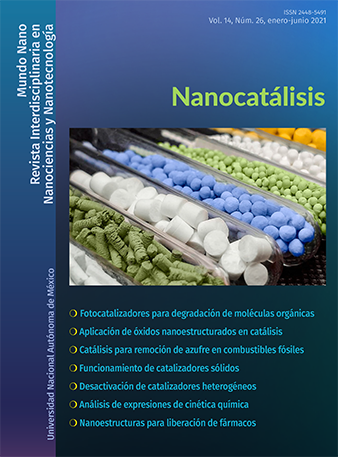Mecanismos de desactivación de catalizadores heterogéneos
Resumen
La desactivación catalítica es un problema serio en las diferentes secciones del proceso de refinación del petróleo, que causa la pérdida de actividad catalítica con respecto al tiempo de operación. La presente revisión está enfocada en los mecanismos de desactivación de catalizadores, tales como envenenamiento, ensuciamiento, degradación térmica y sinterización, degradación química y fallas mecánicas como el desgaste y el aplastado del catalizador, en el craqueo catalítico fluidizado (FCC), la hidrodesulfuración (HDS) y el reformado catalítico. Las causas de estos mecanismos de desactivación catalítica son químicos, térmicos y mecánicos. Se revisan las características y consideraciones clave para cada uno de estos tipos de mecanismos de desactivación. Además, el costo total por la desactivación catalítica aumenta gradualmente cada año debido al remplazo del catalizador gastado, generando miles de toneladas de desechos industriales.
Citas
Al-Khattaf, S. (2002). The influence of Y-zeolite unit cell size on the performance of FCC catalysts during gas oil catalytic cracking. Applied Catalysis A: General, 231(1-2): 293-306. https://doi.org/10.1016/S0926-860X(02)00071-6
Appleby, W. G., Gibson, J. W., Good, G. M. (1962). Coke formation in catalytic cracking. Industrial & Engineering Chemistry Process Design and Development, 1(2): 102-110. https://doi.org/10.1021/i260002a006
Argyle, M. D., Bartholomew, C. H. (2015). Heterogeneous catalyst deactivation and regeneration: A review. Catalysts, 5(1): 145-269. https://doi.org/10.3390/catal5010145
Augustine, S. M., Alameddin, G. N., Sachtler, W. M. H. (1989). The effect of Re, S, and Cl on the deactivation of Pt/γ-Al2O3 reforming catalysts. Journal of Catalysis, 115(1): 217-232. https://doi.org/10.1016/0021-9517(89)90020-1
Bai, P., Etim, U. J., Yan, Z., Mintova, S., Zhang, Z., Zhong, Z., Gao, X. (2018). Fluid catalytic cracking technology: current status and recent discoveries on catalyst contamination. Catalysis Reviews, 61(3): 333-405. https://doi.org/10.1080/01614940.2018.1549011
Bartholomew, C. H., Agrawal, P. K., Katzer, J. R. (1982). Sulfur poisoning of metals. Advances in Catalysis, 31: 135-242. https://doi.org/10.1016/S0360-0564(08)60454-X
Bartholomew, C. H., Farrauto, R. J. (2006). Catalyst deactivation: Causes, mechanisms, and treatment. En Fundamentals of industrial catalytic processes, 2a ed. EUA: John Wiley & Sons, Inc. 260-336. https://doi.org/10.1002/9780471730071.ch5
Castañeda, R., Corma, A., Fornés, V., Martínez-Triguero, J., Valencia, S. (2006). Direct synthesis of a 9x10 member ring zeolite (Al-ITQ-13): A highly shape-selective catalyst for catalytic cracking. Journal of Catalysis, 238(1): 79-87.
Dufresne, P. (2007). Hydroprocessing catalysts regeneration and recycling. Applied Catalysis A: General, 322: 67-75. https://doi.org/10.1016/j.apcata.2007.01.013
Félix Flores, M. G. (2006). Simulación del proceso FCC: Caracterización de las corrientes de alimentación y productos del riser a través de la función de distribución gamma. Tesis de doctorado. Instituto Tecnológico de Celaya, México. http://www.iqcelaya.itc.mx/~richart/TesisDoctorado/2006%20Felix%20Flores.pdf
Fichtl, M. B., Schlereth, D., Jacobsen, N. Kasatkin, I., Schumann, J., Behrens, M., Schlögl, R., Hinrichsen, O. (2015). Kinetics of deactivation on Cu/ZnO/Al2O3 methanol synthesis catalysts. Applied Catalysis A: General, 502: 262-270. https://doi.org/10.1016/j.apcata.2015.06.014
Fuentes, S. (1996). Global overview of research in catalysis, Mexico. Applied Catalysis A: General, 142(1): 179-181. https://doi.org/10.1016/0926-860X(96)00011-7
Furimsky, E., Massoth, F. E. (1999). Deactivation of hydro processing catalysts. Catalysis Today, 52: 381-495. https://doi.org/10.1016/S0920-5861(99)00096-6
Hou, X., Qiu, Y., Yuan, E., Zhang, X., Liu, G. (2017). SO42−/TiO2 promotion on HZSM-5 for catalytic cracking of paraffin. Applied Catalysis A: General, 537: 12-23. https://doi.org/10.1016/j.apcata.2017.03.002
Ino, T., Al-Khattaf, S. (1996). Effect of unit cell size on the activity and coke selectivity of FCC catalysts. Applied Catalysis A: General, 142(1): 5-17. https://doi.org/10.1016/0926-860X(96)00018-X
Kallinikos, L. E., Bellos, G. D., Papayannakos, N. G. (2008). Study of the catalyst deactivation in an industrial gasoil HDS reactor using a mini-scale laboratory reactor. Fuel, 87(12): 2444-2449. https://doi.org/10.1016/j.fuel.2008.03.007
Larsson, A. C. (2007). Study of catalyst deactivation in three different industrial processes. Tesis de doctorado. Växjö University, Sweden. ISBN: 978-91-7636-533-5. https://www.researchgate.net/publication/279641458_Study_of_Catalyst_Deactivation_in_ThreeDifferent_Industrial_Processes/related#fullTextFileContent
Li, J. P., Yang, X. J., Ma, L., Yang, Q., Zhang, Y. H., Bai, Z. S., Fang, X. C., Li, L. Q., Gao, Y., Wang, H. L. (2016). The enhancement on the waste management of spent hydrotreating catalysts for residue oil by a hydrothermal–hydro cyclone process. Catalysis Today, 271: 163-171. https://doi.org/10.1016/j.cattod.2015.08.037
Liu, Z., Zhang, Z., Fan, H., Wang, Y., Liu, P., Yang, C. (2014). Research on the high activity of REY zeolite in fluid catalytic cracking reaction. Applied Petrochemical Research, 4: 385-388. https://doi.org/10.1007/s13203-014-0076-8
Mackor, E. L., Hofstra, A., Van der Waals, J. H. (1958). The basicity of aromatic hydrocarbons. Part 1. Unsubstituted polynuclear compounds. Transactions of the Faraday Society, 54: 66-83. https://doi.org/10.1039/TF9585400066
Martino, G., Boitiaux, J. P. (2002). Les catalyseurs: utilisations actuelles et évolutions prévisibles. L’Actualité Chimique, 257: 7-11. http://www.lactualitechimique.org/Quoi-de-neuf-en-catalyse
Menon, P. G. (1990). Coke on catalysts —harmful, harmless, invisible and beneficial types. Journal of Molecular Catalysis, 59(2): 207-220. https://doi.org/10.1016/0304-5102(90)85053-K
Naccache, C. (1985). Deactivation of acid catalysts. En Jacques Oudar y Henry Wise (cords.), Deactivation and poisoning of catalysts. Nueva York: Marcel Dekker, 185-203. ISBN-10: 0824773381
Qian, K., Tomczak, D. C., Rakiewicz, E. F., Harding, R. H., Yaluris, G., Cheng Cheng, W., Zhao, X., Peters, A.W. (1997). Coke formation in the fluid catalytic cracking process by combined analytical techniques. Energy Fuels, 11(3): 596-601. https://doi.org/10.1021/ef960204u
Seki, H., Yoshimoto, M. (2001). Deactivation of HDS catalyst in two-stage RDS process II. Effect of crude oil and deactivation mechanism. Fuel Processing Technology, 69(3): 229-238. https://doi.org/10.1016/S0378-3820(00)00143-0
Song, C. (1999). A proposed new concept for design of sulfur-resistant noble metal catalysts based on shape-selective exclusion and hydrogen spillover. En Chunshan Song, Juan M. Garcés y Yoshihiro Sugi (cords.), Shape-selective catalysis. ACS Symposium Series, 381-389. https://doi.org/10.1021/bk-2000-0738.ch027
Song, C., Schmitz, A. D. (1997). Zeolite-supported Pd and Pt catalysts for low-temperature hydrogenation of naphthalene in the absence and presence of benzothiophene. Energy Fuels, 11(3): 656-661. https://doi.org/10.1021/ef960179s
Téllez-Romero, J. G., Cuevas-García, R., Ramírez, J., Castillo-Villalón, P., Contreras-Bárbara, R., Salcedo-Luna, M. C., Puente-Lee, R. I. (2015). Simultaneous naphthalene and thiophene hydrogenation over Ni(X)–Pt/HMOR catalysts. Catalysis Today, 250: 12-20. https://doi.org/10.1016/j.cattod.2014.08.032
Vogelaar, B. M. (2005). Deactivation of hydroprocessing catalysts: New insights in catalyst structure, activity and stability. Tesis de doctorado. TU Delft, Delft University of Technology. http://resolver.tudelft.nl/uuid:1f5f31e7-b83a-4b49-b622-bb461ae19d30
Vogt, E. T., Weckhuysen, B. M. (2015). Fluid catalytic cracking: recent developments on the grand old lady of zeolite catalysis. Chemical Society Reviews, 44: 7342-7370. https://doi.org/10.1039/C5CS00376H
Yasuda, H., Yoshimura, Y. (1997). Hydrogenation of tetralin over zeolite-supported Pd-Pt catalysts in the presence of dibenzothiophene. Catalysis Letters, 46(1-2): 43-48. https://doi.org/10.1023/A:1019021224505
Zakari Yusuf, A., Mandafiya John, Y., Olufemi Aderemi, B., Patel, R., Mujtaba, I. M. (2019). Modelling, simulation and sensitivity analysis of naphtha catalytic reforming reactions. Computers & Chemical Engineering, 130: 1-16. https://doi.org/10.1016/j.compchemeng.2019.106531
Zhou, J., Zhao, J., Zhang, J., Zhang, T., Ye, M., Liu, Z. (2020). Regeneration of catalysts deactivated by coke deposition: A review. Chinese Journal of Catalysis, 41(7): 1048-1061. https://doi.org/10.1016/S1872-2067(20)63552-5

Mundo Nano. Revista Interdisciplinaria en Nanociencias y Nanotecnología, editada por la Universidad Nacional Autónoma de México, se distribuye bajo una Licencia Creative Commons Atribución-NoComercial 4.0 Internacional.
Basada en una obra en http://www.mundonano.unam.mx.



